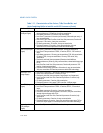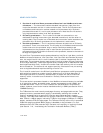
Vol. 3 11-1
CHAPTER 11
MEMORY CACHE CONTROL
This chapter describes the memory cache and cache control mechanisms, the TLBs,
and the store buffer in Intel 64 and IA-32 processors. It also describes the memory
type range registers (MTRRs) introduced in the P6 family processors and how they
are used to control caching of physical memory locations.
11.1 INTERNAL CACHES, TLBS, AND BUFFERS
The Intel 64 and IA-32 architectures support cache, translation look aside buffers
(TLBs), and a store buffer for temporary on-chip (and external) storage of instruc-
tions and data. (Figure 11-1 shows the arrangement of caches, TLBs, and the store
buffer for the Pentium 4 and Intel Xeon processors.) Table 11-1 shows the character-
istics of these caches and buffers for the Pentium 4, Intel Xeon, P6 family, and
Pentium processors. The sizes and characteristics of these units are machine
specific and may change in future versions of the processor. The CPUID
instruction returns the sizes and characteristics of the caches and buffers for the
processor on which the instruction is executed. See “CPUID—CPU Identification” in
Chapter 3, “Instruction Set Reference, A-M,” of the Intel® 64 and IA-32 Architec-
tures Software Developer’s Manual, Volume 2A.
Figure 11-1. Cache Structure of the Pentium 4 and Intel Xeon Processors
Trace Cache
Instruction Decoder
Bus Interface Unit
System Bus
Data Cache
Unit (L1)
(External)
Physical
Memory
Store Buffer
Data TLBs
L2 Cache
Instruction
TLBs
L3 Cache
†
† Intel Xeon processors only


















